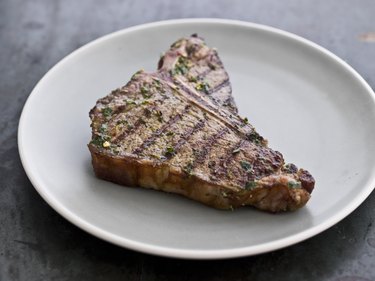
When it comes to tender cuts of beef, the T-bone steak hails from the area of the cow that produces the most tender varieties. A tenderizing marinade for T-bone steak may help some, but how you cook your meat really determines its tenderness.
The T-Bone Steak
Video of the Day
When it comes to choosing your steak, you may ask yourself, "What's better: ribeye or T-bone?" According to the Cattlemen's Beef Board and National Cattlemen's Beef Association, the ribeye is the number one cut of beef in the United States, while the T-bone steak comes in at number three after the strip steak. But the better steak really depends on your personal taste preferences.
Video of the Day
The T-bone steak comes from the loin primal cut, which produces some of the most tender and popular cuts, including the tenderloin, strip steak and porterhouse. The T-bone is a cut from the short loin and includes a T-shaped piece of lumbar bone, which explains the name, that separates two types of steak, including the strip and tenderloin.
The marbling in the T-bone steak plays a major role in is flavor and tenderness. However, the marbling also makes it a high-calorie, high-fat cut of beef. According to nutrition information provided by the USDA, a 3.5-ounce serving of broiled T-bone steak has 258 calories, 24 grams of protein, 17 grams of total fat and 6.4 grams of saturated fat.
Red meat like the T-bone steak tends to be higher in fat and saturated fat than poultry and seafood. Higher intakes of saturated fat increases blood cholesterol and the risk of heart disease. According to the U.S. National Library of Medicine, you should limit your saturated fat intake to no more than 10 percent of total calories per day which is 22 grams if you eat about 2,000 calories a day.
Your T-bone steak may supply nearly 30 percent of your daily saturated fat limit, so you should limit your enjoyment of this well-marbled, tender and tasty cut of meat to special occasions.
T-Bone Steak in an Oven
When it comes to a tender T-bone steak, your cooking method is the most important factor. The Cattlemen's Beef Board and National Cattlemen's Beef Association says grilling and broiling are the best cooking methods. If it's too cold outside to cook your steaks on the grill, the T-bone steak oven method works just as well.
To ensure that your steak remains tender, take the meat out of the refrigerator about 30 minutes before broiling. Then adjust the rack in your oven so that when your steak is in the broiler pan, it sits 3 to 4 inches from the heat source. Season your meat with salt and pepper; place your steak on the broiler pan and then into the oven.
How long you broil your steak depends on the thickness of the cut. The Cattlemen's Beef Board and National Cattlemen's Beef Association recommends 15 to 20 minutes total cooking time for a 1-inch thick T-bone steak. FoodSafety.gov recommends that you cook your steak until it reaches an internal temperature of 145 degrees Fahrenheit.
Once ready, remove your T-bone steak from the oven, cover with aluminum foil and allow your meat to rest for five minutes before serving. Grilling your T-bone steak isn't all that different from broiling, but your steak may cook a lot faster. Be sure to preheat your grill before cooking.
Read more: How to Cook a Tender Steak on the Stove
Tenderizing Your Steak
Because your T-bone steak already has tender meat, flash cooking over dry heat (broiling or grilling) is the best way to keep it tender, according to the American Meat Science Association.
The meat marinades you make at home rely mostly on an acidic medium such as lemon juice or vinegar to tenderize the meat. However, these types of marinades only penetrate the surface of your meat and may not improve the tenderness of your steak, but they do add flavor.
Using the natural enzymes in fruits such as papaya or pineapple may be more effective at tenderizing your meat, in addition to adding flavor. Consider subbing papaya or pineapple for the mango in this LIVESTRONG.com recipe for a refreshing, meat-tenderizing Fresh Mango Marinade for T-bone steaks.
The enzymes in the fruit work fairly quickly so you only need to marinate your 1-inch steak for about 15 minutes. Be careful not to marinate too long or your steak may turn out mushy or dry.
- Cattlemen's Beef Board and National Cattlemen's Beef Association: "The Retail Meat Case: America's Favorite Beef Cuts"
- Cattlemen's Beef Board and National Cattlemen's Beef Association: "T-Bone Steak"
- USDA FoodData Central: "Beef, Short Loin, T-Bone Steak, Separable Lean and Fat, Trimmed to 0" Fat, USDA Choice, Cooked, Broiled"
- U.S. National Library of Medicine: "Saturated Fat"
- Cattlemen's Beef Board and National Cattlemen's Beef Association: "Broiling Time Guidelines"
- FoodSafety.gov: "Safe Minimum Cooking Methods"
- American Meat Association: "Meat Tenderness"